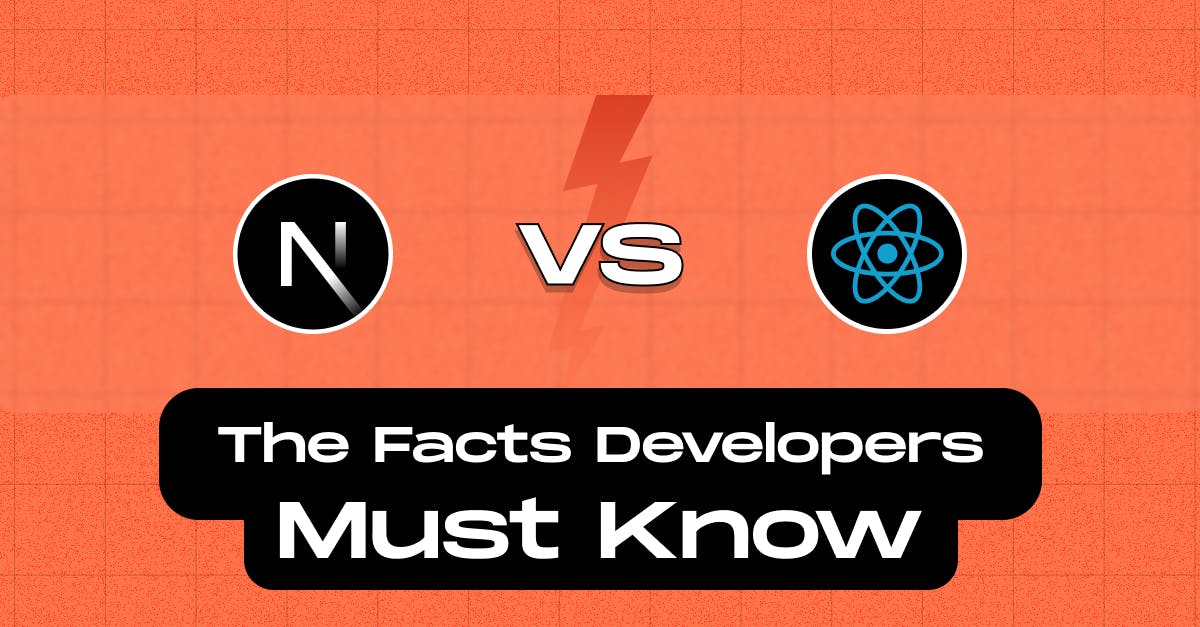May 9, 2024
Next.js vs React: The Facts Developers Must Know

Nusrat Sarmin

If you're deciding between Next.js and React for your upcoming project, understanding the key differences and benefits of each can guide your choice. Let's dive into the ultimate showdown of next.js vs react to help you pick the right tool for the job.
Reader's Digest: Next.js vs React
React and Next.js are like two sides of the same coin. While React provides the foundation, Next.js builds upon it, offering a more streamlined approach. React is a JavaScript library for building interactive user interfaces. Contrarily, Next.js is a flexible React framework that gives you the building blocks to create fast, full-stack web applications. They are often used together, but they serve different purposes and have their own unique features.
Understanding Next.js: A Streamlined React Framework

Next.js is a React-based framework that offers more out-of-the-box features geared towards production-level applications. It enhances React applications by providing a standard way to handle server-side rendering, static site generation, and file-based routing. Next.js aims to solve common issues in React apps, such as SEO friendliness and initial load performance.
It furnishes a plethora of functionalities, including routing, data fetching, and automatic code splitting.
Next.js's future is bright. Its focus on performance, SEO, and developer experience aligns with web development trends. Expect continued innovation in hybrid rendering with features like Incremental Static Regeneration (ISR) for optimal user experience. With a strong community and backing from Vercel, Next.js is poised to be a major player in building next-generation web applications.
Understanding React: Versatile Building Block

React is a JavaScript library, created by Facebook, used for building user interfaces. It adheres to a component-based architecture. React breaks down complex UIs into smaller, reusable building blocks called components. Each component has its own logic and renders a specific part of the UI. This modular approach promotes code reusability, maintainability, and easier collaboration.
React's virtual DOM helps improve performance by minimizing the number of DOM operations needed to update the UI. Additionally, debugging in React is made easier due to its unidirectional data flow from parent to child components only. This helps developers easily trace data changes and identify any issues with their application logic. Its declarative syntax simplifies UI development, making it easier to build complex web applications.
React is not a framework, so it does not provide features such as routing or data fetching like Nextjs.
Head-to-Head Comparison: Next.js vs React
1. Rendering Strategies
- Next.js: Next.js offers a versatility of rendering strategies, encompassing Server-side Rendering (SSR), Static Site Generation (SSG), and Incremental Static Regeneration (ISR). This grants developers the adaptability to pick the most suitable approach for each page of their application:
✔️ SSR: Content is rendered on the server in response to a user request, resulting in enhanced SEO and faster initial page loads.
✔️ SSG: Pages are pre-rendered during the build process, guaranteeing exceptional performance and scalability.
✔️ ISR: Pages are statically generated at build time, with the potential for revalidation on the server at specific intervals, striking a balance between performance and content freshness.
React: Primarily uses Client-Side Rendering (CSR). Here, the UI components are generated in the user's browser after the initial page load. This approach can lead to issues with SEO and slower initial page loads. Since the browser downloads, parses, and executes JavaScript before content is visible.
2. Routing
- Next.js: Comes with a built-in file-based routing system. Pages are automatically routed based on their file names in the pages directory, simplifying the setup process. This convention fosters a well-organized project structure and simplifies routing configuration.
- React: React necessitates the usage of a separate routing library like React Router for defining application routes. Developers must manually set up routes and link components to URLs.
3. Automatic Code Splitting
- Next.js: One of the key features that set Next.js apart from React is its automatic code-splitting functionality. Code splitting breaks up large JavaScript bundles into smaller chunks that can be loaded as needed to improve web performance. Next.js handles code splitting automatically, eliminating the need for developers to manually split their code or configure webpack settings.
- React: React itself does not provide automatic code splitting. In React applications, it can be implemented using additional tools like Webpack.
4. Data Fetching
- Next.js: Next.js provides built-in mechanisms for data fetching. Such as getStaticProps for SSG and getServerSideProps for SSR, getStaticPaths to pre-render pages. These methods allow developers to decide when and how to fetch data, optimizing performance and SEO.
- React: React offers more general flexibility and requires manual setup for data fetching. For data fetching, React requires the usage of third-party libraries like Redux or Apollo Client. This adds an extra layer of complexity to the development process.
5. Live Reloading
- Next.js: Next.js comes with built-in support for hot reloading through its own development server. As you modify your JavaScript and CSS files, Next.js automatically applies the changes in real-time, refreshing the pages as needed.
- React: In a typical React development environment, live reloading (or hot reloading) is not built directly into React itself. It might necessitate additional setup compared to Next.js's built-in solution. Instead, it is implemented through additional tools like Webpack's Hot Module Replacement (HMR) or development servers like Create React App.
6. SEO
- Next.js: Next.js provides more immediate, integrated solutions for SEO compared to React. Next.js significantly simplifies the process of building SEO-friendly websites by providing default server-side rendering and static generation capabilities. Search engines can effortlessly index your content because it's already pre-rendered or rendered on the server.
- React: SEO enhancements can be tricky in pure React apps because they lack server-side rendering and pre-rendering features. React, by itself, requires more custom setups to achieve the same level of SEO friendliness that Next.js offers pre-configured.
7. Developer Experience
- Next.js: Next.js enhances the developer experience by providing a more integrated and opinionated framework. It includes built-in features like routing, server-side rendering, static site generation, automatic code splitting, hot reloading, and built-in image optimization. This reduces setup time and complexity, allowing developers to focus more on building their applications rather than configuring the environment.
- React: Offers more flexibility but requires additional libraries and configurations for functionalities like routing and data fetching. This flexibility can be both empowering and overwhelming.
8. Image Optimization
- Next.js: Features automatic image optimization via the <Image /> component, resizing, optimizing, and serving images in modern formats like WebP. This ensures efficient image delivery tailored to the user's device and brows
- React: This does not include any built-in image optimization tools, relying on external libraries or custom solutions.
9. Error Handling
- Next.js: Next.js furnishes built-in error-handling mechanisms for server-side rendering, routing, and API routes. Utilizes _error.js or an ErrorComponent to customize error pages, and offers onError handler in next.config.js for handling API route errors.
- React: In React, error handling primarily revolves around using error boundaries to catch JavaScript errors within the component tree. Error boundaries are React components that capture errors using lifecycle methods like componentDidCatch or static getDerivedStateFromError, providing a fallback UI.
10. API Routes or Backend API development
- Next.js: Next.js takes a different approach by incorporating Rust-based architecture that allows developers to implement API routes directly within the framework. This means that Next.js offers a more seamless and integrated solution for backend API development compared to React. One of the key advantages of using Next.js for backend API development is its support for API routes within both the Page Router and App Router conventions.
- React: When it comes to backend API development, React relies heavily on external Nodejs-based frameworks such as Express.js or Nest.js. Without these additional tools, building backend APIs with React alone can be quite challenging.
Overall, Next.js provides a more comprehensive and efficient solution for backend API development compared to React's reliance on external frameworks.
11. Static Site Generation (SSG)
- Next.js: Supports static site generation, meaning you can pre-render pages at build time. This feature is especially useful for sites that can pre-build pages ahead of a user's request, like blogs or e-commerce product pages.
- React: Does not support static site generation natively. If developers want to achieve SSG with React, they often need to rely on additional tools and configurations. One common approach is to use tools like Create React App in combination with a static site generator, such as Gatsby or Next.js
12. Built-in Support
- Next.js is a full-fledged framework built on top of React that provides additional features and functionalities built-in. It comes with built-in solutions for common tasks like routing, data fetching, and SEO optimization, allowing developers to focus more on building features rather than configuring the infrastructure.
- React is a JavaScript library that provides developers with the tools needed to create interactive, dynamic web applications. However, React is just the view layer of an application and does not provide any built-in features for server-side rendering or routing.
13. Configuration and Setup
- Next.js: One of the reasons why developers appreciate Next.js is its "zero-config" approach. This allows for quick and easy setup without needing to dive into complex configuration files. Next.js simplifies project configuration by automatically handling aspects like routing and server-side rendering without needing much manual setup. Configuration in Next.js typically involves making adjustments to a next.config.js file to tailor specific functionalities, like incorporating custom webpack configurations or establishing environment variables.
- React: Its configuration tends to be more minimal compared to frameworks like Next.js. Setting up a new React project commonly involves using Create React App, which includes Webpack, Babel, and a development server. However, this abstraction can sometimes be limiting when it comes to customizing the configuration for specific needs. In such cases, "ejecting" the Create React App project becomes necessary to access and modify all the underlying configuration files.
14. Static File Serving
- Next.js: Can serve static files easily along with your dynamic content.
- React: You would need to configure your server separately to serve static files.
15. TypeScript Support
- Both React and Next.js have good support for TypeScript. If you're specifically looking for TypeScript support, both can accommodate.
16. Complexity and Learning Curve:
- Next.js: Abstracts away some of the complexities of React by providing a structured framework, making it easier to get started with SSR, SSG, routing, and other features.
- React: Offers more flexibility but requires more setup and configuration for features like SSR, SSG, and routing.
17. Ecosystem and Community:
- Next.js: While Next.js builds on top of React, it has its own ecosystem and community, which is growing rapidly.
- React: Being the base library, React has a vast ecosystem and a large community, with many libraries and resources available for different needs.
When to Use Nextjs Over React?
👉 Choose Next.js if: You prioritize a faster development experience with built-in features and a structured approach. Next.js thrives in building several different kinds of web applications, especially those that prioritize performance, SEO, or a streamlined development experience.
Use Cases of Next.js:
- JAMstack Applications: Next.js is a perfect fit for building JAMstack applications (JavaScript, APIs, and Markup). Its ability to pre-render content with Static Site Generation (SSG) aligns well with the JAMstack architecture, offering fast performance and scalability.
- Server-Side Rendering (SSR): Next.js excels at Server-Side Rendering (SSR), which is ideal for applications requiring dynamic content that updates frequently. This approach ensures SEO benefits by allowing search engines to easily index your content.
- Static Sites: Next.js also supports generating static websites. This is useful for content-driven websites that don't require frequent updates. Static sites offer lightning-fast load times and minimal server resources needed, making them cost-effective.
- E-commerce Platforms: Next.js is a great fit for e-commerce websites due to its ability to handle dynamic content like product listings and shopping carts. It can ensure a fast user experience while keeping SEO optimized for product discovery.
- Content-Heavy Websites: For websites with a lot of content that changes frequently, Next.js offers flexibility. It can handle both static site generation (SSG) for pre-rendering content and server-side rendering (SSR) for dynamic content updates.
- Serverless Functions and APIs: Next.js allows you to create serverless functions and APIs directly within your application using the pages/api directory. This simplifies development and deployment for backend functionalities.
- Progressive Web Apps (PWAs): Next.js can be a strong foundation for building PWAs, which offer app-like features and offline functionality. Its built-in features like code-splitting and service workers contribute to a PWA's smooth user experience.
When to Use React Over Nextjs?
👉 Go for React if: Your project demands maximum flexibility and customization. This is ideal for complex web applications where you need full control over routing, data handling, and UI structure.
Use Cases of React
- Single-Page Applications (SPAs): React excels at building SPAs, where users experience a seamless interaction without full-page reloads. This creates a more fluid and responsive user experience.
- Dynamic User Interfaces: React's component-based architecture makes it perfect for crafting dynamic UIs. Components can update independently based on changes in the application's state, leading to a more efficient and performant UI.
- Mobile App Development (with React Native): Although React itself is for web development, React Native allows you to leverage React skills to build mobile apps for iOS and Android using native components.
- Real-Time Applications: React's efficient rendering process makes it suitable for real-time applications like chat or dashboard applications that require frequent updates.
- Interactive Web Applications: The combination of React's virtual DOM and efficient rendering makes it ideal for creating interactive and responsive web applications.
- Complex UIs: React's component-based approach allows you to break down complex UIs into smaller, reusable, and maintainable components.
- Client-side Rendering (CSR): In specific use cases, CSR with React offers advantages such as faster initial load times. It also enhances user experience for simple UIs. However, consider potential drawbacks like limited SEO benefits and reliance on JavaScript for core functionalities.
The Final Verdict: React vs Next.js
So, React or Next.js? It all boils down to your project's needs and your coding style. React and Next.js are both rockstars in the web development world, but they cater to different styles. While React itself is a powerful library for building user interfaces, Next.js extends its capabilities by addressing common web development challenges directly.
Your project's specific needs will dictate whether a streamlined library like React or a more feature-complete framework like Next.js is the best fit.
We hope this Next.js vs React guide has equipped you to choose the perfect tool for your next web project. Happy Coding! ✌️
Transform your business with a cutting-edge website! StaticMania offers expert website development, innovative JAMStack strategies, headless CMS solutions, e-commerce development and more. Let's chat and make it happen!

